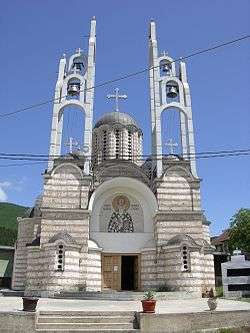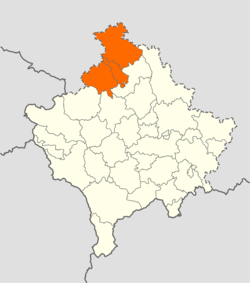Leposavić
| Leposavić | ||
|---|---|---|
| Municipality and city | ||
|
Serbian: Лепосавић/Leposavić Albanian: Leposaviq | ||
|
Church of St. Basil of Ostrog | ||
| ||
 Leposavić Location in Kosovo | ||
| Coordinates: 43°06′N 20°48′E / 43.100°N 20.800°ECoordinates: 43°06′N 20°48′E / 43.100°N 20.800°E | ||
| Country | Kosovo[lower-alpha 1] | |
| District | District of Mitrovica | |
| Government | ||
| • Mayor | Branko Ninić | |
| Area | ||
| • Total | 539 km2 (208 sq mi) | |
| Elevation | 450 m (1,480 ft) | |
| Population (2014) | ||
| • Total | 13,515 | |
| • Density | 25/km2 (65/sq mi) | |
| Time zone | CET (UTC+1) | |
| • Summer (DST) | CEST (UTC+2) | |
| Postal code | 42000 | |
| Area code(s) | +381 | |
| Car plates | 02 | |
| Climate | Cfb | |
| Website | Leposavić | |
Leposavić (pronounced [lɛ̌pɔsaʋitɕ], Serbian Cyrillic: Лепосавић, Albanian: Leposaviq) is a town and the northernmost municipality in the District of Mitrovica in Kosovo. It is a part of North Kosovo, a region populated mostly with ethnic Serbs that functions largely autonomously from the remainder of Kosovo, which is majority ethnic Albanian. According to OSCE and UNHCR estimates, the municipality has a population of approximately 18,600 (2007).[1] The municipality consists of a town and 72 villages with an area of 539 km².
Settlements
Bare · Belo Brdo · Beluće · Berberište · Bistrica · Borova · Borčane · Brzance · Vitanoviće · Vračevo · Vuča · Gnježdane · Gornji Krnjin · Graničane · Grkaje · Guvnište · Gulije · Desetak · Dobrava · Donje Isevo · Donji Krnjin · Dren · Duboka · Zabrđe · Zavrata · Zemanica · Zrnosek · Ibarsko Postenje · Jarinje · Jelakce · Jošanica · Kajkovo · Kamenica · Kijevčiće · Koporiće · Kostin Potok · Košutica · Košutovo · Kruševo · Kruščica · Kutnje · Lazine · Leposavić · Lešak · Lozno · Majdevo · Mekiniće · Miokoviće · Mioliće · Mošnica · Ostraće · Plakaonica · Planinica · Popovce · Potkomlje · Pridvorica · Rvatska · Rodelj · Rucmance · Seoce · Slatina · Sočanica · Tvrđan · Trebiće · Trikose · Ćirkoviće · Ulije · Ceranja · Crveni · Crnatovo · Šaljska Bistrica
History
Middle Ages
The Sočanica Monastery was founded in the 13th century by King Stefan Milutin. Many of the settlements were mentioned in the Studenica charters of King Stefan Dečanski (r. 1321-1331).
Contemporary
From 1877 to 1913 Leposavić was part of Kosovo vilayet.
After the First Balkan War (1912), Kosovo was internationally recognised as a part of Serbia and northern Metohija as a part of Montenegro at the Treaty of London in May 1913. In 1918, the Kingdom of Serbs, Croats and Slovenes, later named Yugoslavia was established by the merging of the Western South Slavic states. Between 1929 and 1941, the region was administratively part of the Zeta Banovina.
Lešak, Belo Brdo, Vračevo, Berberište were incorporated into the Leposavić municipality in 1953.
In the mid-1950s, the Assembly of PR Serbia decided that the Leposavić municipality be ceded to AD Kosovo and Metohija, after requests by the Kosovo leadership.[2] It had up until then been part of the Kraljevo srez, of which the population was wholly Serb.[2] After this, the number of Serbs drastically fell.[2] In 1959, Leposavić was incorporated into the province.[3][4]
After the NATO bombing of Yugoslavia, the political group Pokret za Leposavić ("Movement for Leposavić") was established, which sought to bring together those committed to cooperation and communication with the international community and the Albanians.[5]
The municipality assembly joined the Association of Serb Municipalities and Settlements of Kosovo and Metohija in 2003, which exercised legislative and executive authority over North Kosovo and other Serb enclaves.
Economy
Almost all industrial facilities are closed or work with reduced capacity. The unemployment rate is also high, and it has been considerably increased due to the closing down of most of the Trepča conglomerate facilities. The municipality is rich in natural, infrastructure and management, but current circumstances blocked all the potentials. The municipality adopted the Development Agenda 2006 – 2009, in cooperation with UNOPS and with the support of UNMIK and the Italian Government, which foresees improvement in the local economy. Given the current difficult situation,however, there is not much hope the Agenda will be properly implemented. The municipality, led by a very proactive CEO, pays noteworthy efforts toward identifying and initiating projects ideas.[1]
Culture
Monuments
The municipality has several monuments protected by the Republic of Serbia as part of the cultural heritage list.
- Sočanica Monastery
- Monastery of Cosmas and Damian
Demographics
Leposavić municipality includes 72 villages with a total of 18,600 inhabitants, according to the UNHCR and OSCE estimates. Ethnic Serbs constitute the supermajority (18,000), while small numbers of other communities are also present. Approximately 200 Kosovo Albanians live in the three southern villages of Košutovo, Šaljska Bistrica, and Ceranje. There are also 240 Kosovo Bosniaks, Roma, Ashkalis, and Egyptians.
| Ethnic composition, including IDPs | |||||||||||||
| Year/Population | Albanians | % | Serbs | % | Muslims/Bosniaks | % | Roma | % | Total | ||||
|---|---|---|---|---|---|---|---|---|---|---|---|---|---|
| 19911 | 1,101 | 6.7 | 14,306 | 87.8 | 600 | 3.7 | 163 | 1.0 | 16,291 | ||||
| January 19992 | 902 | N/A | 15,365 | N/A | 940 | N/A | N/A | N/A | N/A | ||||
| October 20073 | 280 | 1% | 18,000 | 97% | 420 | 1% | 2504 | 1% | 20,600 | ||||
| |||||||||||||
According to the 1991 census, the municipality of Leposavić had a population of 16,395 people.
See also
Annotations
- ↑ Kosovo is the subject of a territorial dispute between the Republic of Kosovo and the Republic of Serbia. The Republic of Kosovo unilaterally declared independence on 17 February 2008, but Serbia continues to claim it as part of its own sovereign territory. The two governments began to normalise relations in 2013, as part of the Brussels Agreement. Kosovo has received formal recognition as an independent state from 111 out of 193 United Nations member states.
References
- 1 2 OSCE "Municipal profile of Leposavić" (PDF)., October 2007. Retrieved on 9 March 2008.
- 1 2 3 Dragoslav Despotović (1993). Raskršća, ili, Autoportret bivšeg narodnog neprijatelja. Nova Iskra. p. 463.
- ↑ Marksistička misao. Marksistički centar Centralnog komiteta Saveza komunista Srbije. 1988. p. 209.
опћина Лепосавић (која је припојена САПК 1959. године)
- ↑ Miloš Macura (1989). Problemi politike obnavljanja stanovništva u Srbiji. Srpska akademija nauka i umetnosti. p. 74.
- ↑ NIN.: Nedeljne informativne novine. Politika. 2001. p. 2.
Sources
- Благоје Павловић (2003). Насеља и миграције становништва општине Лепосавић. Институт за српску културу Приштина.
- Milka Stojanovic (2009). ИБАРСКИ Колашин - природа и традицијска култура: зборник радова. Centar za Naučna Istraživanja SANU i Univ. u Kragujevcu. ISBN 978-86-81037-24-9.
- Милисав В Лутовац (1954). Ибарски Колашин: антропогеографска испитивања. Издавачко Предузеђе Народне Републике Србије.
External links
| Wikimedia Commons has media related to Leposavić. |



